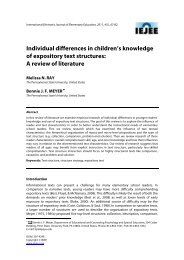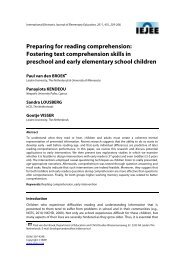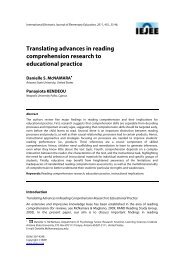Internati<strong>on</strong>al Electr<strong>on</strong>ic Journal <str<strong>on</strong>g>of</str<strong>on</strong>g> Elementary Educati<strong>on</strong>A propositi<strong>on</strong>al analysis (Kintsch, 1998) was used to determine <strong>the</strong> difference between<str<strong>on</strong>g>syntactic</str<strong>on</strong>g>ally simple <str<strong>on</strong>g>and</str<strong>on</strong>g> complex texts. <str<strong>on</strong>g>The</str<strong>on</strong>g> average number <str<strong>on</strong>g>of</str<strong>on</strong>g> propositi<strong>on</strong>s per sentence for<strong>the</strong> simple <str<strong>on</strong>g>and</str<strong>on</strong>g> embedded versi<strong>on</strong>s <str<strong>on</strong>g>of</str<strong>on</strong>g> <strong>the</strong> texts is summarized in Table 2. Across <strong>the</strong> fourtopics, <strong>the</strong> difference between <strong>the</strong> simple <str<strong>on</strong>g>and</str<strong>on</strong>g> complex versi<strong>on</strong> is c<strong>on</strong>sistently about 4propositi<strong>on</strong>s per topic.Lexical <str<strong>on</strong>g>complexity</str<strong>on</strong>g> was indexed by <strong>the</strong> presence or absence <str<strong>on</strong>g>of</str<strong>on</strong>g> academic (crossdisciplinaryor scientific) words that directly relate to science c<strong>on</strong>cepts or processes <str<strong>on</strong>g>and</str<strong>on</strong>g> arebey<strong>on</strong>d <strong>the</strong> 1000 most frequent words according to Zeno et al. (1995). High-frequency words(words within 1000 most frequent) are referred to as “everyday words.” To verify <strong>the</strong>differences across <strong>the</strong>se passages, <strong>the</strong> st<str<strong>on</strong>g>and</str<strong>on</strong>g>ard frequency index (SFI) <str<strong>on</strong>g>of</str<strong>on</strong>g> <strong>the</strong> words in eachpassage were computed. <str<strong>on</strong>g>The</str<strong>on</strong>g> higher <strong>the</strong> SFI, <strong>the</strong> more frequently <strong>the</strong> word is used in texts(e.g., <strong>the</strong> = 88.3; sanitize = 25.6). <str<strong>on</strong>g>The</str<strong>on</strong>g> average SFIs for academic <str<strong>on</strong>g>and</str<strong>on</strong>g> everyday versi<strong>on</strong>s across<strong>the</strong> four topics are reported above in Table 2. Averaged across <strong>the</strong> four topics, <strong>the</strong> differencebetween <strong>the</strong> mean SFI values <str<strong>on</strong>g>of</str<strong>on</strong>g> <strong>the</strong> academic <str<strong>on</strong>g>and</str<strong>on</strong>g> everyday versi<strong>on</strong>s was 16 (<strong>the</strong> differencebetween <strong>the</strong> mean SFI value <str<strong>on</strong>g>of</str<strong>on</strong>g> each <str<strong>on</strong>g>of</str<strong>on</strong>g> <strong>the</strong> individual topics were within three points <str<strong>on</strong>g>of</str<strong>on</strong>g> this).Since <strong>the</strong> remaining porti<strong>on</strong>s <str<strong>on</strong>g>of</str<strong>on</strong>g> <strong>the</strong> texts (i.e., <strong>the</strong> first <str<strong>on</strong>g>and</str<strong>on</strong>g> last 25% <str<strong>on</strong>g>of</str<strong>on</strong>g> each text) areequivalent, <str<strong>on</strong>g>and</str<strong>on</strong>g> since <strong>the</strong> functi<strong>on</strong> words for all manipulated versi<strong>on</strong>s are high in frequency,<strong>the</strong> focus <str<strong>on</strong>g>of</str<strong>on</strong>g> <strong>the</strong> analyses was <strong>on</strong> <strong>the</strong> everyday <str<strong>on</strong>g>and</str<strong>on</strong>g> complex versi<strong>on</strong> <str<strong>on</strong>g>of</str<strong>on</strong>g> academic words.For each topic, 10 questi<strong>on</strong>s were c<strong>on</strong>structed to measure students’ comprehensi<strong>on</strong>. Half<str<strong>on</strong>g>of</str<strong>on</strong>g> <strong>the</strong> questi<strong>on</strong>s were multiple-choice <str<strong>on</strong>g>and</str<strong>on</strong>g> half required short-answer resp<strong>on</strong>ses. An example<str<strong>on</strong>g>of</str<strong>on</strong>g> a multiple-choice questi<strong>on</strong> is <strong>the</strong> following: What makes plants grow? a. rocks; b. vitamins;c. bugs; d. wind. <str<strong>on</strong>g>The</str<strong>on</strong>g> short-answer resp<strong>on</strong>ses were c<strong>on</strong>structed to elicit a specific resp<strong>on</strong>se,such as <strong>the</strong> following: Write two ways that animals help plants. <str<strong>on</strong>g>The</str<strong>on</strong>g> questi<strong>on</strong>s for a given topicwere <strong>the</strong> same, regardless <str<strong>on</strong>g>of</str<strong>on</strong>g> <strong>the</strong> manipulated c<strong>on</strong>diti<strong>on</strong> that students received. Four <str<strong>on</strong>g>of</str<strong>on</strong>g> <strong>the</strong>10 questi<strong>on</strong>s targeted <strong>the</strong> c<strong>on</strong>tent <str<strong>on</strong>g>of</str<strong>on</strong>g> <strong>the</strong> manipulated porti<strong>on</strong> <str<strong>on</strong>g>of</str<strong>on</strong>g> <strong>the</strong> text; <strong>the</strong> remaining sixquesti<strong>on</strong>s referred to <strong>the</strong> first <str<strong>on</strong>g>and</str<strong>on</strong>g> last 25% porti<strong>on</strong> <str<strong>on</strong>g>of</str<strong>on</strong>g> <strong>the</strong> text (three questi<strong>on</strong>s for eachporti<strong>on</strong>). Two <str<strong>on</strong>g>of</str<strong>on</strong>g> <strong>the</strong> four questi<strong>on</strong>s for <strong>the</strong> treated porti<strong>on</strong> were explicit recall <str<strong>on</strong>g>of</str<strong>on</strong>g> informati<strong>on</strong>from <strong>the</strong> text <str<strong>on</strong>g>and</str<strong>on</strong>g> two required <strong>the</strong> student to make inferences based <strong>on</strong> what <strong>the</strong>y readfrom this porti<strong>on</strong>. <str<strong>on</strong>g>The</str<strong>on</strong>g> remaining six questi<strong>on</strong>s also c<strong>on</strong>sisted <str<strong>on</strong>g>of</str<strong>on</strong>g> both direct recall <str<strong>on</strong>g>and</str<strong>on</strong>g>inferential questi<strong>on</strong>s.<str<strong>on</strong>g>The</str<strong>on</strong>g> short-answer questi<strong>on</strong>s (e.g., How do frogs get away from <strong>the</strong>ir enemies?) were scored<strong>on</strong> a scale <str<strong>on</strong>g>of</str<strong>on</strong>g> 0-1-2. A rubric was c<strong>on</strong>structed to assign no, partial or full credit. No credit wasgiven to resp<strong>on</strong>ses that were irrelevant (e.g., <strong>the</strong>y like to swim). Partial credit was given toresp<strong>on</strong>ses that included part <str<strong>on</strong>g>of</str<strong>on</strong>g> <strong>the</strong> intended answer (e.g., <strong>the</strong>y hop around). Full credit wasgiven to complete <str<strong>on</strong>g>and</str<strong>on</strong>g> accurate answers (e.g., <strong>the</strong>y hop around really fast). A sample <str<strong>on</strong>g>of</str<strong>on</strong>g> 20%<str<strong>on</strong>g>of</str<strong>on</strong>g> <strong>the</strong> resp<strong>on</strong>ses was double-scored; <strong>the</strong> inter-rater agreement was 95%.Reliability <str<strong>on</strong>g>and</str<strong>on</strong>g> validity <str<strong>on</strong>g>of</str<strong>on</strong>g> measureAll experimenter-designed assessments were piloted to determine validity <str<strong>on</strong>g>and</str<strong>on</strong>g> reliability.After revisi<strong>on</strong>, <strong>the</strong> prior knowledge assessment had a Cr<strong>on</strong>bach’s alpha coefficient <str<strong>on</strong>g>of</str<strong>on</strong>g> .85 <str<strong>on</strong>g>and</str<strong>on</strong>g>correlated str<strong>on</strong>gly with <strong>the</strong> QRI timed miscue measure (.65, p < .01), teacher ranking <str<strong>on</strong>g>of</str<strong>on</strong>g>reading ability (.57, p < .01) <str<strong>on</strong>g>and</str<strong>on</strong>g> performance <strong>on</strong> <strong>the</strong> STAR (.67, p < .01).<str<strong>on</strong>g>The</str<strong>on</strong>g> comprehensi<strong>on</strong> assessments for <strong>the</strong> experimental texts <strong>on</strong> <strong>the</strong> four topics, Tree Frogs,Soil, Jelly Beans <str<strong>on</strong>g>and</str<strong>on</strong>g> Toothpaste, had a Cr<strong>on</strong>bach’s alpha coefficient <str<strong>on</strong>g>of</str<strong>on</strong>g> .86. <str<strong>on</strong>g>The</str<strong>on</strong>g>secomprehensi<strong>on</strong> assessments str<strong>on</strong>gly correlated with <strong>the</strong> state reading assessment (.56, .67,.74, .63; p < .01) <str<strong>on</strong>g>and</str<strong>on</strong>g> <strong>the</strong> QRI timed miscue measure (.51, .50, .51, .51; p < .01).116
<str<strong>on</strong>g>The</str<strong>on</strong>g> Effects <str<strong>on</strong>g>of</str<strong>on</strong>g> Syntactic <str<strong>on</strong>g>and</str<strong>on</strong>g> Lexical / Arya, Hiebert & Pears<strong>on</strong>ProceduresThree experienced researchers collected all <str<strong>on</strong>g>of</str<strong>on</strong>g> <strong>the</strong> data for <strong>the</strong> present study. To reduce <strong>the</strong>possibility <str<strong>on</strong>g>of</str<strong>on</strong>g> priming <strong>the</strong> participants <strong>on</strong> key vocabulary, <strong>the</strong> prior knowledge measure wasadministered individually in <strong>on</strong>e sessi<strong>on</strong>, al<strong>on</strong>g with <strong>the</strong> QRI task, at least three weeks prior to<strong>the</strong> experimental reading task. <str<strong>on</strong>g>The</str<strong>on</strong>g> passage reading/comprehensi<strong>on</strong> tasks took place in twosessi<strong>on</strong>s as whole-class events <strong>on</strong> two separate days; each <str<strong>on</strong>g>of</str<strong>on</strong>g> <strong>the</strong>se sessi<strong>on</strong>s lastedapproximately 50 minutes.All participants read four passages with <strong>the</strong> c<strong>on</strong>straint that each student received eachtopic <str<strong>on</strong>g>and</str<strong>on</strong>g> each versi<strong>on</strong> <strong>on</strong>ce <str<strong>on</strong>g>and</str<strong>on</strong>g> <strong>on</strong>ly <strong>on</strong>ce. <str<strong>on</strong>g>The</str<strong>on</strong>g>re were 4 topics <str<strong>on</strong>g>and</str<strong>on</strong>g> 4 versi<strong>on</strong>s per topic,yielding 16 unique reading tasks (a passage followed by <strong>the</strong> comprehensi<strong>on</strong> itemsc<strong>on</strong>nected with that particular topic). <str<strong>on</strong>g>The</str<strong>on</strong>g>se reading tasks were assigned to participantsusing a Latin-square design, which resulted in complete counterbalancing for <strong>the</strong> order inwhich both topic <str<strong>on</strong>g>and</str<strong>on</strong>g> versi<strong>on</strong> were presented. In o<strong>the</strong>r words, each <str<strong>on</strong>g>of</str<strong>on</strong>g> <strong>the</strong> 16 reading taskswas completed equally <str<strong>on</strong>g>of</str<strong>on</strong>g>ten in <strong>the</strong> first through fourth testing positi<strong>on</strong>s across students. Toavoid fatigue, participants completed two reading tasks <strong>on</strong> <strong>the</strong> first day <str<strong>on</strong>g>and</str<strong>on</strong>g> two <strong>on</strong> <strong>the</strong>sec<strong>on</strong>d day <str<strong>on</strong>g>of</str<strong>on</strong>g> testing. As an example, <strong>on</strong>e student might have read Tree Frogs in <strong>the</strong><str<strong>on</strong>g>syntactic</str<strong>on</strong>g>ally simple/everyday vocabulary versi<strong>on</strong> <str<strong>on</strong>g>and</str<strong>on</strong>g> Soil in <strong>the</strong> <str<strong>on</strong>g>syntactic</str<strong>on</strong>g>allysimple/academy vocabulary versi<strong>on</strong> <strong>on</strong> day <strong>on</strong>e, followed by Toothpaste in <strong>the</strong> <str<strong>on</strong>g>syntactic</str<strong>on</strong>g>allycomplex/everyday vocabulary versi<strong>on</strong> <str<strong>on</strong>g>and</str<strong>on</strong>g> Jelly Beans in <strong>the</strong> <str<strong>on</strong>g>syntactic</str<strong>on</strong>g>allycomplex/academically vocabulary versi<strong>on</strong> <strong>on</strong> day two. It required a total <str<strong>on</strong>g>of</str<strong>on</strong>g> 64 participants tocomplete <strong>on</strong>e complete replicate <str<strong>on</strong>g>of</str<strong>on</strong>g> <strong>the</strong> 4 topics X 4 versi<strong>on</strong>s X four serial testing positi<strong>on</strong>sdesign.Participants were given as much time as needed to read <strong>the</strong> text <str<strong>on</strong>g>and</str<strong>on</strong>g> <strong>the</strong>n answer <strong>the</strong>questi<strong>on</strong>s, but each text was collected directly before distributing questi<strong>on</strong>s. <str<strong>on</strong>g>The</str<strong>on</strong>g>y wererequired to answer each set <str<strong>on</strong>g>of</str<strong>on</strong>g> questi<strong>on</strong>s based <strong>on</strong> memory <str<strong>on</strong>g>of</str<strong>on</strong>g> what had been read, without<strong>the</strong> opportunity to look back at <strong>the</strong> text. Tables 3a <str<strong>on</strong>g>and</str<strong>on</strong>g> 3b show <strong>the</strong> total performance <strong>on</strong>each text by versi<strong>on</strong> <str<strong>on</strong>g>and</str<strong>on</strong>g> topic as well as specific performance <strong>on</strong> <strong>on</strong>ly <strong>the</strong> treated porti<strong>on</strong>s.ResultsA series <str<strong>on</strong>g>of</str<strong>on</strong>g> 2-step (students were level 1 <str<strong>on</strong>g>and</str<strong>on</strong>g> classrooms, level 2), hierarchical linear modelswere fit to <strong>the</strong> data to examine <strong>the</strong> relati<strong>on</strong>ship between treatment (<str<strong>on</strong>g>syntactic</str<strong>on</strong>g> <str<strong>on</strong>g>and</str<strong>on</strong>g>/or <str<strong>on</strong>g>lexical</str<strong>on</strong>g><str<strong>on</strong>g>complexity</str<strong>on</strong>g>) <str<strong>on</strong>g>and</str<strong>on</strong>g> performance <strong>on</strong> <strong>the</strong> treated secti<strong>on</strong>s <str<strong>on</strong>g>of</str<strong>on</strong>g> <strong>the</strong> text, while simultaneouslyaccounting for variance due to <strong>the</strong> clustering <str<strong>on</strong>g>of</str<strong>on</strong>g> students within classrooms. A r<str<strong>on</strong>g>and</str<strong>on</strong>g>omintercept was included in <strong>the</strong> model; it permitted different mean performance levels acrossclassrooms. No r<str<strong>on</strong>g>and</str<strong>on</strong>g>om slopes were included in this model due to <strong>the</strong> small number <str<strong>on</strong>g>of</str<strong>on</strong>g>classrooms (N = 10) as well as <strong>the</strong> implausibility <str<strong>on</strong>g>and</str<strong>on</strong>g> irrelevance <str<strong>on</strong>g>of</str<strong>on</strong>g> classroom-specific <str<strong>on</strong>g>effects</str<strong>on</strong>g><str<strong>on</strong>g>of</str<strong>on</strong>g> treatment <strong>on</strong> performance. No additi<strong>on</strong>al classroom variables were c<strong>on</strong>sidered in <strong>the</strong>present study. Such analyses, which would have allowed for more level-2 covariates, wouldhave required a much larger sample <str<strong>on</strong>g>of</str<strong>on</strong>g> classrooms than was available.Error-variance histograms revealed that <strong>the</strong> error variance from each <str<strong>on</strong>g>of</str<strong>on</strong>g> <strong>the</strong> regressi<strong>on</strong>models fit was normally distributed. Also, predicted-versus-observed scatterplots <str<strong>on</strong>g>of</str<strong>on</strong>g> <strong>the</strong>outcome variables revealed that <strong>the</strong> error variance was c<strong>on</strong>stant across <strong>the</strong> range <str<strong>on</strong>g>of</str<strong>on</strong>g> data.Thus, <strong>the</strong> assumpti<strong>on</strong>s <str<strong>on</strong>g>of</str<strong>on</strong>g> regressi<strong>on</strong> modeling were met for <strong>the</strong> data used in this study.This study uses a modest form <str<strong>on</strong>g>of</str<strong>on</strong>g> HLM, with a r<str<strong>on</strong>g>and</str<strong>on</strong>g>om intercept <strong>on</strong>ly <str<strong>on</strong>g>and</str<strong>on</strong>g> no level-2covariates. In Raudenbush <str<strong>on</strong>g>and</str<strong>on</strong>g> Bryk’s (2002) notati<strong>on</strong>, our full model (which corresp<strong>on</strong>ds toModel 3 described below) is described by this formula:117





